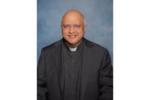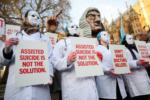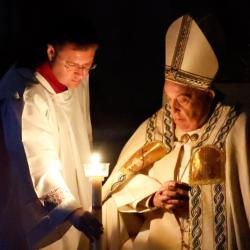Annual financial report shows improvements, challenges
BRAINTREE -- The overall financial health of the Archdiocese of Boston is improving and its central administration is on course to operate in the black by 2010 according to the archdiocese’s 2008 Annual Financial Report that was set to be released April 30 on its website www.BostonCatholic.org.
At the same time, the report also states that the clergy pension fund remains in jeopardy of collapse; the lay pension fund is not fully funded; while parish collections continue to grow, nearly 20 percent of the parishes are unable to raise the funds they need for their daily operations; and there are great financial challenges facing the archdiocese’s Catholic schools.
Archdiocesan officials speaking to The Pilot about the report April 28 acknowledged the challenges but expressed their overall encouragement at its findings.
Vicar General and Moderator of the Curia Father Richard Erikson described the results of the report as a “great blessing” saying that it shows the “enormous generosity of Catholics throughout the archdiocese, even in the midst of the downturn of the economy.”
“The fact that Catholics continue to give to the appeal and their (parish) offertories is a wonderful blessing, a sign of people’s generosity and commitment,” he said.
Chancellor James P. McDonough shared that positive assessment but admitted that there are still several areas of concern, particularly the clergy fund which he described as “our number one priority.”
“We are realistic but we have some great challenges in front of us,” he said.
The central administration announced a year ago that they anticipated a $4 million deficit for fiscal year 2008, a $2 million deficit for 2009 and breaking even on 2010. The current report confirms last year’s assessment for 2008, slightly adjusts the projection of a the 2009 deficit to $2.3 million and confirms the expectation that by fiscal year 2010 the central administration will balance its budget.
“It will be a challenge, but we must do so,” said McDonough. “Parishes live within their means; we, too, must get to a point where we can do the same.”
The archdiocese relocated its headquarters from Brighton to Braintree last June and the report states that the archdiocese purchased the 150,000 square-foot office building for $25.8 million, which was funded by a donor’s gift.
The archdiocese then spent $4.3 million in building improvements and $3.4 million in furniture and equipment.
Additionally, the archdiocese had over $4 million in “one time charges” mostly related to the move to its new headquarters including $1.9 million in buyouts offered to employees before the move, and $1 million in expenses related to the move that could not be capitalized.
The report also focuses on the current situation of the clergy and lay pension funds, stating that both, “have been diminished by the general market decline.”
The clergy fund is currently underfunded by $114 million, and the report states that “if continued as currently structured and operated would run out of cash in 2011.”
It goes on to state that changes are being made to stabilize the program including “a significant restructuring of expenses charged to clergy fund, several fundraising initiatives including a third annual collection for the clergy fund -- in addition to the current Easter and Christmas collection -- an annual fundraising event and a major gift campaign.”
McDonough said, “We are confident that we will be able to meet the needs of our priests moving forward.”
“Failure is not an option; we have several very important steps that we are taking and we will continue to take them through the support of the clergy fund’s board we expect to bridge that gap by 2011,” he added.
Speaking about the lay pension plan, McDonough explained that, “we are not unlike many not for profit organizations that are faced with the same difficulties regarding their pension plans in which investments took a terrible hit.”
“Thankfully, our investment committee of the Financial Council did a masterful job in helping us take a path that kept this pretty liquid, so, while we had a decline in our investments, it is substantially better than most of the major indices,” he said.
The lay pension fund, which was fully funded last year, was 90 percent funded at the end of fiscal year 2008.
In addition to looking at the archdiocese’s central operations, the report also looks at the financial condition of all 292 parishes and the 84 schools and 42 cemeteries operated by the parishes.
The report states that parish offertories continued their upward trend, increasing 4 percent from the prior year.
It also notes that 45 parishes in the archdiocese, mostly in urban areas, have been funding ongoing operations from one-time property sales because their weekly offertory does not cover their operating expenses.
McDonough said that the goal of each parish should be to support their ongoing operations with their collections and fundraisers and not by diminishing their patrimony. He said that administrative staff will be working with those parishes on a plan that will bring their expenses in line with their income.
McDonough added that those are not the only parishes unable to make the ends meet. Another 8 to 10 inner-city parishes are being subsidized at any given moment.
“There are some parishes that will be subsidized forever, because there is an important pastoral mission that is taking place in those locations and we need to support them,” he said.
Father Erikson said that the long term solution for most parishes with ongoing financial difficulties will be a culture of planning and will include consolidation of staff.
“There will be consolidation of resources to help meet the needs of the people and our missions,” he said
McDonough explained that, as the number of clergy decreases, more lay people will have to be hired to help in the parish, but those new positions will be often shared among several parishes.
“More folks will be doing more of that, sharing as opposed to competing.”
Father Erikson said the future model of parishes will often involve one pastor serving several parishes that work together.
“We have great models of parishes coming together and working together that have had great success.”



















